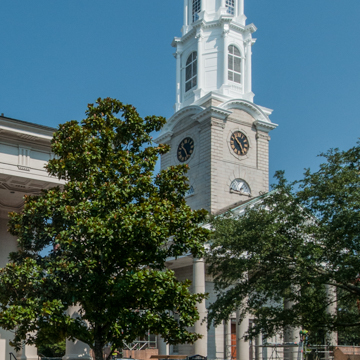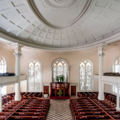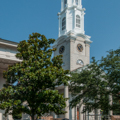Chartered by George II in 1756, the independent Presbyterians—identified as "dissenters" and "professors of the doctrines of the Church of Scotland"—built their first meetinghouse on Ellis Square soon after. A new meetinghouse on Telfair Square was completed around 1800. Less than two decades later, however, following rapid growth of the congregation, they acquired five contiguous lots within the northwestern tything of Brown Ward to build the present church. This building closely follows the design of Greene's own First Congregational Church in Providence, Rhode Island, completed in 1816; apart from the portico and interior dimensions, the two are remarkably similar. When this church was destroyed by fire in 1889, the session voted to rebuild it exactly as it had been. The reconstructed church differs from the original in having granite columns rather than brick, as well as a taller and more slender steeple, made possible by using steel and iron rather than wood above the masonry base. The steeple is 227 feet high, the tallest structure in the downtown. Among the most monumental buildings in the city, the church's capacious interior is remarkable for its suspended wooden dome, mahogany pulpit, and exquisitely crafted classical details—though it lacks any representational art or symbolism, consistent with Puritan and Reformed traditions. The wide central aisle accommodates tables and benches used for the celebration of the Lord's Supper. The massive split-case design of a new organ (the fifth in the church), built by Rieger-Kloss of the Czech Republic and installed in 2005, required the construction of a centrally placed choir loft.
You are here
Independent Presbyterian Church
1817-1819, John Holden Greene; 1891 rebuilt, William G. Preston. 25 W. Oglethorpe Ave.
Coordinator:
Robin B. Williams
If SAH Archipedia has been useful to you, please consider supporting it.
SAH Archipedia tells the story of the United States through its buildings, landscapes, and cities. This freely available resource empowers the public with authoritative knowledge that deepens their understanding and appreciation of the built environment. But the Society of Architectural Historians, which created SAH Archipedia with University of Virginia Press, needs your support to maintain the high-caliber research, writing, photography, cartography, editing, design, and programming that make SAH Archipedia a trusted online resource available to all who value the history of place, heritage tourism, and learning.









